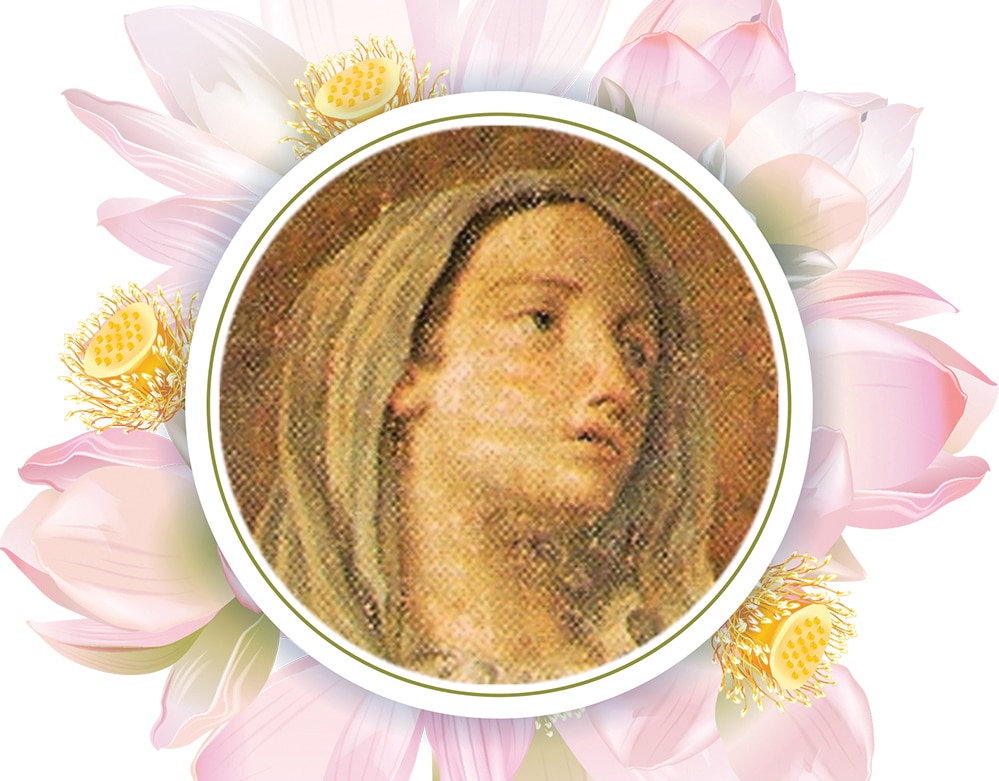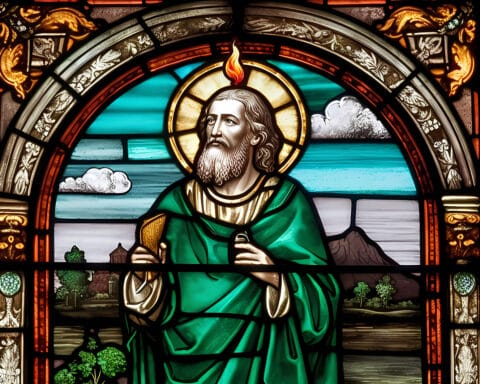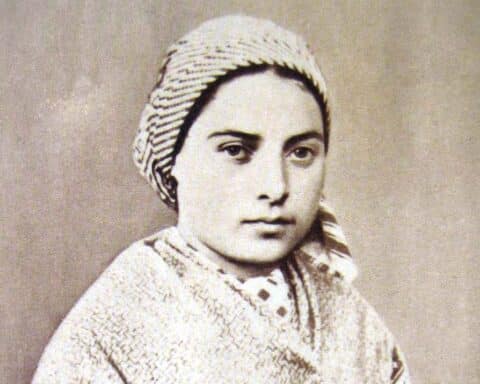This is the fourth in a series of women in Church history.
Every year thousands of people join the Catholic Church. Among other beliefs, catechumens are asked to comprehend and accept the doctrine of purgatory. Many of these new Catholics receive only a partial, incomplete or vague explanation of purgatory. Even people who were born and raised Catholic are limited in knowledge, perhaps due to the lack of exposure or informed catechesis. One saint who provided extensive insight into this doctrine is Caterina Fieschi Adorono, better known as St. Catherine of Genoa.
Born in 1447, Catherine lived her entire life in Genoa, Italy. She belonged to no religious order, never met the pope and didn’t have a unique worldly talent. But at age 27 she became a holy woman, one called by God. If she had any claim to fame it was that she was a member of the powerful, aristocratic Fieschi family of Italy, which produced Pope Innocent IV (r. 1243-54) and Pope Adrian V (r. 1276).
As a pious child devoted to Jesus, Catherine, at age 13, wanted to enter a convent, but she was considered too young. When she was 16 her parents arranged for her to be married to a member of another aristocratic family, Giuliano Adorno. It did not start out as such a good marriage.
Married life and conversion
Giuliano was immature, reckless with finances, unfaithful and bad-tempered. For several years Catherine accepted her situation and turned toward the attractions of the world, thus becoming lukewarm in her faith. She spent about five years without much religious direction and found herself growing increasingly unhappy and despondent.
One day, when visiting her sister, a nun, she was encouraged to go to confession. As she was kneeling, her soul was overwhelmed by the love of God, and at the same time, she had a vision of her sins and all her life’s miseries. Immediately she recognized that her worldly life could never bring the joy and peace of God. She was so rapt in ecstasy that she fell to the ground. This experience was similar to the sudden conversion of St. Paul. “[W]ithin a day or two she had a vision of Our Lord carrying his cross which caused her to cry out, ‘O Love, if it be necessary, I am ready to confess my sins in public!’ Then she made a general confession of her whole life with such sorrow ‘as to pierce her soul.’ On the feast of the Annunciation she received holy Communion, the first time with fervor for 10 years, and shortly after became a daily communicant … a rare thing in those days” (“Lives Of The Saints, Vol II,” Alban Butler).
She gave up her worldly finery and turned totally to God. She vowed there would be no more sin; her life became one of prayer and of austere living. Catherine wore a hair shirt, practiced extreme fasting, slept rarely, ate little, and fell in love with the Eucharist. Her soul was on fire for Christ. Catherine’s conversion impacted her husband, who also gave up the worldly life and became a third-order Franciscan. Together they began to care for the poor and volunteered at the city hospital to help with the sick.
Catherine was tireless in these acts of mercy, seeking out the most destitute, cleaning their houses, washing their clothes, treating their illnesses. She went into the homes of lepers, trying to bring comfort to those experiencing that dread disease. When a plague broke out in 1493, she courageously gave herself to assisting hundreds who were afflicted. In serving the sick and poor, she was like St. Elizabeth of Hungary (1207-31), who also gave up all earthly attachments and spent the last part of her life assisting in a hospital, tending to the needy. Catherine was a model of those Jesus referred to, saying: “Whatever you did for one of these least brothers of mine, you did for me” (Mt 25:40).
Revelation of purgatory
The Catholic belief in purgatory and praying for the dead can be traced back to the Old Testament in 2 Maccabees 12:41-46. It is a belief widely held by the early Church Fathers; for example, St. Clement of Alexandria (150-215) wrote, “By punishment after death, men must expiate the least sin before they can enter heaven.” Additionally, the Catechism says, “All who die in God’s grace and friendship, but still imperfectly purified, are indeed assured of their eternal salvation: but after death they undergo purification, so as to achieve the holiness necessary to enter the joy of heaven” (No 1030). Ecumenical Church councils, including the Second Council of Lyons in 1274, Florence in 1439 and Trent in 1563, affirmed that the doctrine of purgatory be believed by every Catholic.
From the time of her conversion, Catherine experienced the special gifts of a mystic, including a unique wisdom about purgatory, recognizing that, at death, the soul has one of three destinations or conditions: heaven, hell or purgatory. The latter isn’t hell, and it isn’t heaven. Her belief emphasizes a joyful expectation of purgatory instead of the traditional focus primarily on suffering and pain. “In her day [purgatory] was depicted mainly using images linked to space: a certain space was conceived of in which purgatory was supposed to be located. Catherine, however, did not see purgatory as a scene in the bowels of the earth: for her, it is not an exterior but rather an interior fire. This is purgatory: an inner fire” (“Holy Men and Women,” Pope Benedict XVI).
Catherine reasoned that, except for heaven, there is no greater happiness than found in purgatory. While not dismissing the spiritual suffering, she saw purgatory as a place or condition we enter into knowing it will lead to God; it is a stepping stone to heaven. The sufferings of purgatory, she believed, are the manifestations of God’s love. Here, “rust which is sin, covers souls, and … is burnt away by fire, the more it is consumed, the more the soul responds to God. … As the rust lessens and the soul is opened to the divine rays, happiness grows” (“Treatise on Purgatory,” St. Catherine of Genoa).
Death and legacy
Catherine died in 1510 at age 63, allegedly after contracting a disease from one of her patients. She was buried in the hospital chapel, but 18 months later the casket was damaged by water and the tomb was opened to check the remains. “[T]he casket was found in a deplorable condition; however, the body of the saint remained perfectly incorrupt and spotless. … Many miracles were recorded as having taken place at this time, and a popular cultus began” (“The Incorruptibles,” Joan Carroll Cruz).
In 1737, she was canonized by Pope Clement XII (r. 1730-40). Catherine wrote two classic works: “A Treatise on Purgatory” and “A Dialogue of the Soul and the Body.” The Church concluded these writings alone were evidence of her sanctity.
D.D. Emmons writes from Pennsylvania.
| Catherine rejected indulgences |
|---|
|
Catherine did not seek the Church doctrine of indulgences as a way to shorten or eliminate her time in purgatory. She didn’t doubt the merits of indulgences, but preferred the pain of purgatory to satisfy any temporal punishment due from her sins. When considering her for sainthood, the Vatican “did not consider her rejection of indulgences as negatively impacting her virtue.” They concluded “that we should not confound safety with perfection: It appears indeed to be safer to atone for one’s fault both by one’s own good works and by indulgences, but not more perfect, supposing that a man abstains from indulgences because his love of God and his detestation of having offended him are so great that his desires to make satisfaction to him by bearing the whole of the merited punishment” (“The Mystical Element of Religion: As Studied in Saint Catherine of Genoa and Her Friends, Vol. I,” Baron Von Hugel).
|





